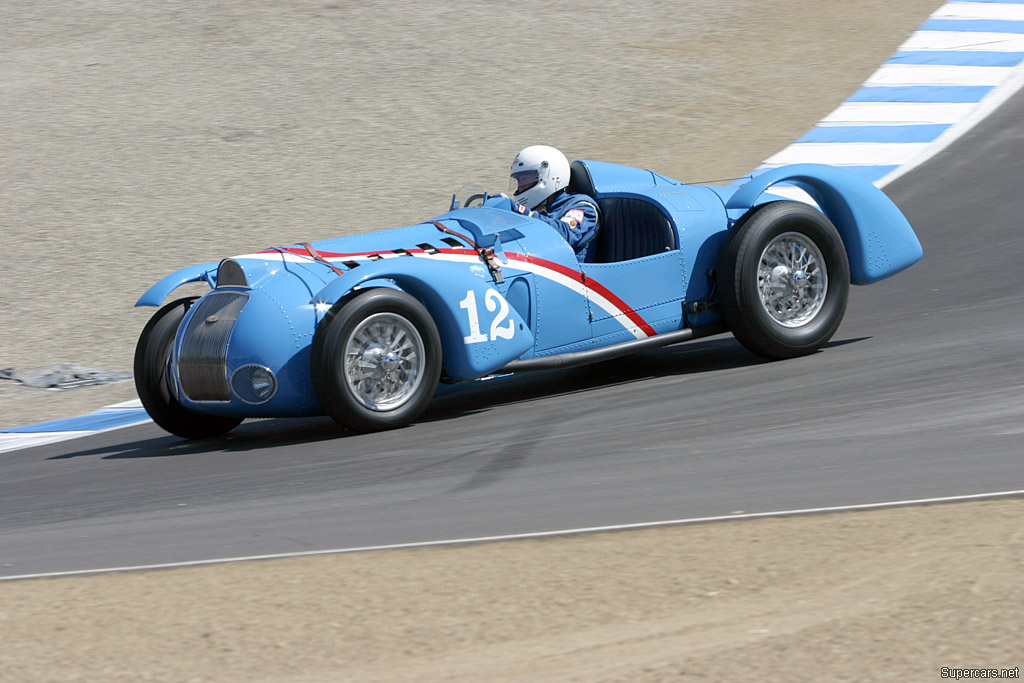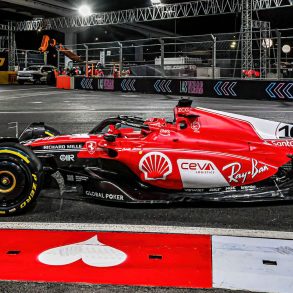Delahaye 145 Grand Prix
Car: Delahaye 145 GP / Engine: 60º V12 / Maker: Delahaye / Bore X Stroke: 75.0 mm x 84.7 mm / Year: 1937 / Capacity: 2,993 cc / Class: Grand Prix / Power: 245 bhp / 183 KW @ 5,500 rpm / Wheelbase: 2,700 mm / Track: Front: 1347 mm Rear: 1362 mm / Weight: 1,100 kilo (2,425 lbs)
Lucy O’Reilly-Schell was the only child of an American multi-millionaire of Irish origin. On a trip to Europe after the First World War she met Laury Schell, an American who had lived in France since his early youth. Both were ardent racing enthusiasts and after they got married they settled in France, their names became well known within the small continental racing fraternity.
The Schell’s long term goal was to build a team, Ecurie Bleue, and a relationship with a automobile manufacturer along the lines of the Scuderia Ferrari and Alfa Romeo. This was all news to Delahaye when In 1934 she became an investor with the Delahaye company when she approached Delahaye with a request that they build a car suitable for racing. When Delahaye demurred she had collected orders from twelve wealthy friends and the 135 Compétition Spéciale was born.
Meanwhile in France the left wing French Government of the Popular Front, who were backed by the Communist Party, sought to encourage French automobile manufacturers to develop race cars capable of competing with the German Mercedes-Benz and Auto Union teams.
The fact that the German teams were backed by the rival Nazi government in a (largely successful) attempt to dominate the sport, in order to ‘prove the superiority of the Aryan race’ was something that the French, the birthplace of automobile racing found particularly galling. For this effort, that had the enthusiastic support of the Automobile Club De France (ACF), prize money of a million francs or around $40,500 which at current rates of inflation would equal $650K was collected by diverting five francs from the fee of each new French driver’s license. In order to ensure that the competition tested each car’s ultimate limits rather than just the driver’s skill in passing other drivers, the race was a time trial against the clock at the partially banked Autodrome de Montlhéry. Each car had to drive sixteen laps (200 kilometers (120 mi)) at an average speed of at least 146 km/h (91 mph) from a standing start. This speed was calculated based upon the average winning speed from the last French Grand Prix held on the same track (Caracciola W25) with an additional 10% tacked on for good measure.
To win the event, Delahaye worked with financial banking and support from Lucy O’Reilly Shell’s Ecurie Bleue team. They had Jean Francois design an unsupercharged, 4.5 liter V12 that fit well within the Grand Prix regulations. The valve train was distinct, having three camshafts, one in the center of the V for both banks of intake valves and two located on the outside for the exhaust. The intention was to offer a detuned version for GT cars, of which two were made, but for the trial magnesium alloy cylinder heads, block and crankcase were used, as well as a lightweight valve train and a special counter-balanced crank shaft. Covered in crude aluminum bodywork which Dreyfus remarked that it was “the ugliest car he ever saw”, and supported by a chassis similar to the 135 S, the V12 project was completed in a year and raced a few times before its high speed test. The ‘Prix du Million’ also had a deadline of August 31st 1937. Ettore Bugatti was one of the first to take up the challenge and were soon joined by Delahaye with assistance from the Ecurie Bleue team. René Dreyfus was signed to be the primary driver of the effort.
The start was scheduled for 10:00 a.m. Refusing to speak to anyone prior to the race, maybe his last race, René Dreyfus set a literally blistering pace, wearing the special Dunlop tires down to the fabric, but would his average speed of 146.6 kph hold up against the Bugatti onslaught that surly must come and they waited. After his record run, Finally on the 31st, the last day possible, the Bugatti arrived an set about their efforts to beat his time. During this tense period, Dreyfus sat on his record, but decided a final run was needed in case Bugatti had any tricks up their sleeve. At the same time, both Dreyfus and Jean-Pierre Wimille took to the track. Both men driving faster than they had ever wanted to drive, each willing his car forward until the Bugatti dropped out with piston trouble, the challenge was over. Dreyfus bested his previous time and became a national hero. He later described it as the ”toughest fight of my career”. He had not only won, he had survived. The price money was split 50/50 between Delahaye and the Ecurie Bleue team with Dreyfus in turn getting half of the teams share.
Afterwards Lucy O’Reilly Shell from Ecurie Bleue had a red and white victory stripe painted on all their cars in recognition of their famous feat. The Million-Franc car along with a sister car was then taken to the Mille Miglia where Dreyfus and Maurice Varet placed forth, hampered by a holed radiator after ariving in second place at Rome. While two 145s raced in Le Mans in 1938, they both dropped out with the victory going to one of the more reliable Delahaye Type 135 Sports driven by Eugène Chaboud and Jean Trémoulet. Dreyfus would finish the year Champion of France for 1938.
Delahaye Triumphs over Mercedes
The first race of the 1938 Grand Prix season was held on the street circuit at Pau in southwestern France. Of the German teams only Mercedes sent two of their new W154s. Alfa Corse the factory team had taken over for the dissolved Scuderia Ferrari. Lucy O’Reilly Schell’s Ecurie Bleue team entered two Delahaye 145s driven by Frenchman René Dreyfus and Italian Gianfranco Comotti. During practice both Mercedes were still being sorted out and were suffering from clutch slip and oiled up plugs. Later in the session Lang lost control of his car and and crashed and his car was withdrawn. Nuvolari suffered from a ruptured fuel tank causing his car to catch fire prompting an angry Nuvolari vow that he would never race an Alfa Romeo again.
In the race Caracciola took the lead of the race followed by Dreyfus, Trintignant, Lanza and his teammate Comott. On the twisty Pau street track Dreyfus was able to keep pace with the Mercedes. The fuel consumption of the Delahaye was about half of that of the supercharged Mercedes cars and the track had become slippery from oil and rubber making it impossible for Caracciola to use the power advantage of the Mercedes-Benz. With half of the race gone Caracciola came into the pits for fuel. The braking and gear changing on the Pau circuit had taken a toll on Caracciola’s old leg injury and he gave over his car to Lang. Dreyfus took over the lead never to be challenged again as he was running on a nonstop strategy. Lang’s car could only finish a frustrating second followed by Comotti in third.
When the Germans seized control of France during World War II, the ‘Million Franc Delahaye’ was disassembled and hidden by sentimental French patriots to prevent it from falling into German hands, and its whereabouts subsequently became unknown. Since then, two different cars have surfaced with credible claims to be the ‘Million Franc Delahaye’.




















